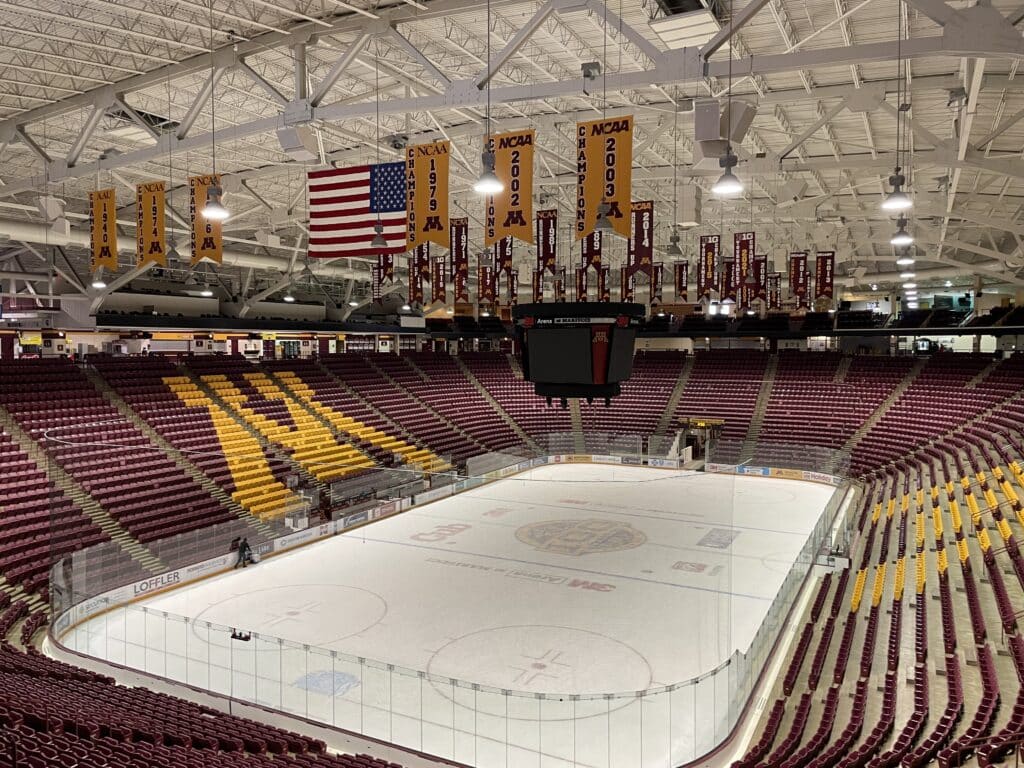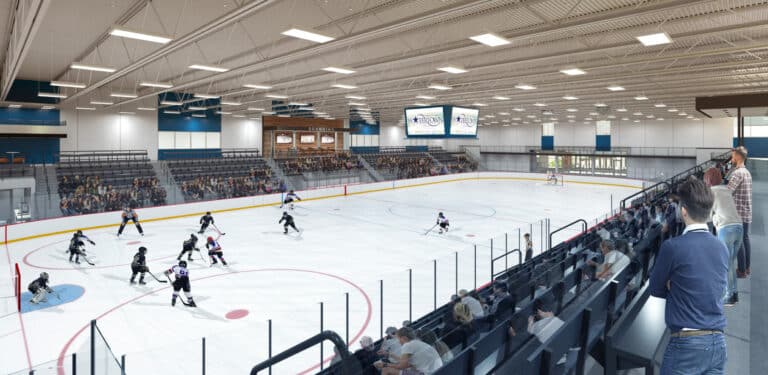Those who watch or play ice hockey in North America have most certainly noticed the epidemic of shrinking rinks; a growing debate with Olympic ice versus NHL ice at the center of the mystery. The differences between the two really come down to size, and in this case, bigger isn’t necessarily better. While the Olympic sheet is larger, it is inversely much less popular for users, particularly hockey teams. If a competitive team has its home ice on the larger ice sheet, it can be an issue when practicing or playing on a smaller NHL rink. As a solution, the ice industry is seeing a marked shift in the phasing out of Olympic ice sheets in new buildings and the conversion/reduction of ice in existing buildings.
Current standard rink sizes are 85’ x 200’ for NHL rinks and 100’ x 200’ for Olympic-sized rinks. Ice markings are the same between them – the Olympic rinks simply have more room from the circles to the side boards. Most European rinks are Olympic size, not because of the Olympics but because European hockey style of play has tended to be more about movement and less contact, using open space, much like soccer, and more content with lower scoring games. Naturally, North American fans prefer more goals and more contact.
Olympic-sized rinks in North America started gaining popularity after the 1980 Miracle on Ice Winter Olympics in Lake Placid, NY. Colleges, in particular, were quick to jump on the idea, and in the late 1980s – early 1990s, there were many new rinks built with 100’x200’ ice sheets. The thought was that programs could pitch the idea of developing players into Olympic athletes – which was an understandable draw at the time. The coaches hoped to open up the game with more flow and movement, less hitting, and more space to use creatively. Since that time, these hopes have not panned out.
The North American hockey community – especially in Canada, where virtually no Olympic size ice sheets have been built unless specifically for the Olympic Games – have not warmed to this idea of European style play. To reinforce how negative the idea of Olympic-sized ice sheets is, when Vancouver, BC, built new rinks for Olympic training and early round competition in their city for 2010, they deliberately designed the facilities with the standard 85’ wide refrigeration loops and dasher board connection points, and the extra 15’ width with its own refrigeration loop and dasher board connections. This way, after the Olympic Games, they could shut down and bypass the extra ice width, move the dasher boards in, and essentially abandon the Olympic ice size. No Olympic size collegiate ice rink has been built for non-Olympic use since 1999.
To counter this, some rinks have been built in what is often referred to as a “hybrid” ice sheet size. Like a lot of major league baseball parks, NCAA rules allow rinks to have slightly different dimensions. The hybrids range from 87 feet to somewhere in the 90s in width, while remaining 200 feet long. Sometimes this is due to physical constraints, but most often it is due to the desire to find that perfect mix of extra room and the seemingly gargantuan width of the Olympic sheet. The idea is that today’s players are considerably bigger and faster than decades past, and the additional five-plus feet allows them to better showcase those physical traits. 92.5 feet is discussed as a nice “standard” since it is exactly halfway between 85’ and 100’.
Brian Burke of NHL coaching fame has been a proponent for a nice round 90’ width, even lobbying NHL team owners to consider that number when building new arenas. While new buildings haven’t been quick to jump on this idea, some have already begun shifting mindsets and building with the ability to convert to 90’ wide into new rinks. In other words, the ice sheets are built at 85’ wide, but refrigeration and dasher board connections are included to allow the change in the future. If this “future hybrid” planning happens in a new rink, care must be taken to consider the additional seating and how it is handled.
The big “pond” at the University of Minnesota’s 3M at Mariucci began size reduction to a hybrid size as of spring 2023 – part of the replacement of the entire refrigeration system – and neighboring St. Cloud State University is planning the same process at the Herb Brooks National Hockey Center. The biggest issue when Olympic rinks try to downsize is that if the ice sheet size is reduced, fixed spectator seating is then too far away from the boards, which is no good for paying fans. Therefore, the rink surface must typically drop a few feet to allow that new space to be infilled with more seats. Those extra seats then force updates in life safety and egress calculations. Many times, the building’s existing structure must be altered to allow the new seating to be properly fitted. 3M at Mariucci – alongside JLG and build partner, M.A. Mortenson – is handling this by creating some customized premium seating experiences for fans at ice level.
Regardless of the motivation for downsizing ice sheet sizes, one thing is certain: the number of Olympic ice sheets is falling quickly in North America and not likely to return. If you have the chance to watch a game on the big ice, take advantage while you still can.
Here is a list of collegiate rinks not considered NHL or Olympic size (as of 2023):
Boston University – 90
Notre Dame – 95
Wisconsin Kohl Center – 92.5
Army – 90
Dartmouth – 90
U Mass – 95
Northeastern – 90
Vermont – 90




